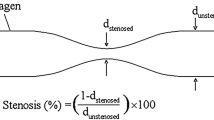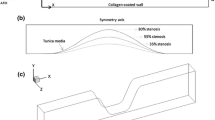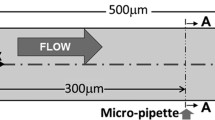Abstract
Recently, neglect of either shear stress, surface saturation, or thrombus growth in mathematical models of platelet deposition has been identified as leading cause of inability to match experimental evidence. While the consideration of shear stress is necessary to obtain at least some qualitative agreement, purely shear-dependent approaches yield notable quantitative discrepancies. In a previous paper, the author demonstrated that surface saturation significantly improves model predictions. However, discrepancies still persist when thrombus growth is neglected. Therefore, the present work develops a free boundary problem which takes this into account. Numerical simulations are performed using the level set method. The results agree well with measurements in stagnation point flow and tubular expansions, which demonstrates the coupling of flow, platelet adhesion, and aggregate growth in primary hemostasis.
Similar content being viewed by others
References
Affeld K, Reininger AJ, Gadischke J, Grunert K, Schmidt S, Thiele F (1995) Fluid mechanics of the stagnation point flow chamber and its platelet deposition. Artif Organs 19(7): 597–602
Babuska I (1969) Numerical solution of boundary value problems by the perturbated variational principle. Technical report, University of Maryland
Barstad RM, Kierulf P, Sakariassen KS (1996) Collagen induced thrombus formation at the apex of eccentric stenoses—a time course study with non-anticoagulated human blood. Thromb Haemostasis 75(4): 685–692
Becker R, Braack M (2000) Multigrid techniques for finite elements on locally refined meshes. Numer Linear Algebra Appl 7(6): 363–379
Becker R, Braack M (2004) A two-level stabilization scheme for the Navier-Stokes equations. In: Feistauer M et al (eds) ENUMATH 2003. Numerical Mathematics and Advanced Applications. Springer, Heidelberg, pp 123–130
Becker R, Braack M, Dunne T, Meidner D, Richter T, Schmich M, Vexler B (2006) The finite element toolkit Gascoigne (2006). http://www.gascoigne.uni-hd.de
Becker R, Dunne T (2007) VisuSimple: an interactive open source visualization utility for scientific computing. In: Jäger W, Rannacher R, Warnatz J (eds) Reactive flows, diffusion and transport: from experiments via mathematical modeling to numerical simulation and optimization. Springer, New York. http://visusimple.uni-hd.de
Braack M, Burman E (2006) Local projection stabilization for the Oseen problem and its interpretation as a variational multiscale method. SIAM J Numer Anal 43(6): 2544–2566
Brash JL, Brophy JM, Feuerstein IA (1976) Adhesion of platelets to artificial surfaces: effect of red cells. J Biomed Mater Res 10: 429–443
Chen S, Merriman B, Osher S, Smereka P (1997) A simple level set method for solving Stefan problems. J Comput Phys 135: 8–29
David T, Thomas S, Walker PG (2001) Platelet deposition in stagnation point flow: an analytical and computational simulation. Med Eng Phys 23: 299–312
Goldsmith HL, Turitto VT (1986) Rheological aspects of thrombosis and haemostasis: basic principles and applications. Thromb Haemostasis 55(3): 415–435
Javierre E, Vuik C, Vermolen FJ, Segal A (2005) A level set method for particle dissolution in a binary alloy. Technical report, Delft University of Technology
Jordan A, David T, Homer-Vanniasinkam S, Graham A, Walker PG (2004) The effects of margination and red cell augmented platelet diffusivity on platelet adhesion in complex flow. Biorheology 41: 641–653
Juric D, Tryggvason G (1996) A front-tracking method for dendritic solidification. J Comput Phys 123: 127–148
Karino T, Goldsmith HL (1979) Adhesion of human platelets to collagen on the walls distal to a tubular expansion. Microvasc Res 17(3): 238–262
Kroll MH, Hellums JD, McIntire LV, Schafer AI, Moake JL (1996) Platelets and shear stress. Blood 88(5): 1525–1541
Kulkarni S, Dopheide SM, Yap CL, Ravanat C, Freund M, Mangin P, Heel KA, Street A, Harper IS, Lanza F, Jackson SP (2000) A revised model of platelet aggregation. J Clin Invest 105(6): 783–791
Lee D, Chiu Y-L, Jen C-Y (1999) Wall stresses and platelet adhesion in a t-junction. Proc Natl Sci Counc ROC (A) 23(2): 303–310
Nitsche J (1971) Über ein Variationsprinzip zur Lösung von Dirichlet-Problemen bei Verwendung von Teilräumen die keinen Randbedingungen unterworfen sind. Abh Math Univ Hamburg 36: 9–15
Osher S, Fedkiw RP (2003) Level set methods and dynamic implicit surfaces. Springer, Berlin
Rannacher R (1984) Finite element solution of diffusion problems with irregular data. Numer Math 43: 309–327
Saad Y, Schultz MH (1986) GMRES: a generalized minimal residual algorithm for solving non-symmetric linear systems. SIAM J Sci Stat Comput 7: 856–869
Sakariassen KS, Baumgartner HR (1989) Axial dependence of platelet-collagen interactions in flowing blood: upstream thrombus growth impairs downstream platelet adhesion. Arteriosclerosis 9(1): 33–42
Savage B, Saldivar E, Ruggeri ZM (1996) Initiation of platelet adhesion by arrest onto fibrinogen or translocation on von Willebrand factor. Cell 84(2): 289–297
Sorensen EN, Burgreen GW, Wagner WR, Antaki JF (1999) Computational simulation of platelet deposition and activation: I. Model development and properties. Ann Biomed Eng 27(4): 436–448
Sussman M, Smereka P, Osher S (1994) A level set approach for computing solutions to incompressible two-phase flow. J Comput Phys 114: 146–159
Tryggvason G, Bunner B, Esmaeeli A, Juric D, Al-Rawahi N, Tauber W, Han J, Nas S, Jan Y-J (2001) A front-tracking method for the computations of multiphase flow. J Comput Phys 169: 708–759
Weller FF (2008) Modeling, analysis, and simulation of thrombosis and hemostasis. PhD thesis, University of Heidelberg. http://www.ub.uni-heidelberg.de/archiv/8558
Weller FF (2008) Platelet deposition in non-parallel flow. Influence of shear stress and changes in surface reactivity. J Math Biol 57: 333–359
Zydney AL, Colton CK (1988) Augmented solute transport in the shear flow of a concentrated suspension. Physicochem Hydrodyn 10: 77–96
Author information
Authors and Affiliations
Corresponding author
Rights and permissions
About this article
Cite this article
Weller, F.F. A free boundary problem modeling thrombus growth. J. Math. Biol. 61, 805–818 (2010). https://doi.org/10.1007/s00285-009-0324-1
Received:
Revised:
Published:
Issue Date:
DOI: https://doi.org/10.1007/s00285-009-0324-1




